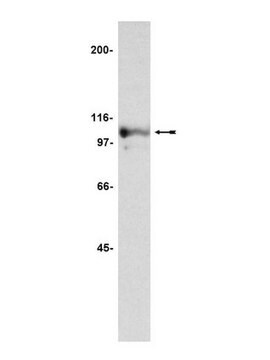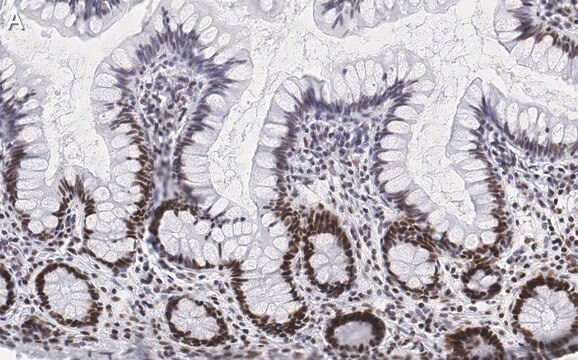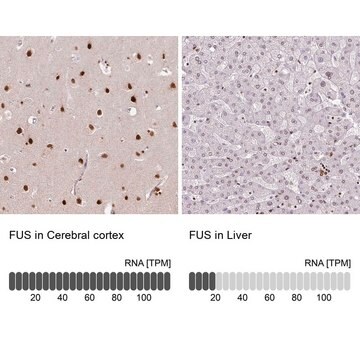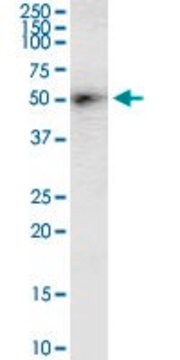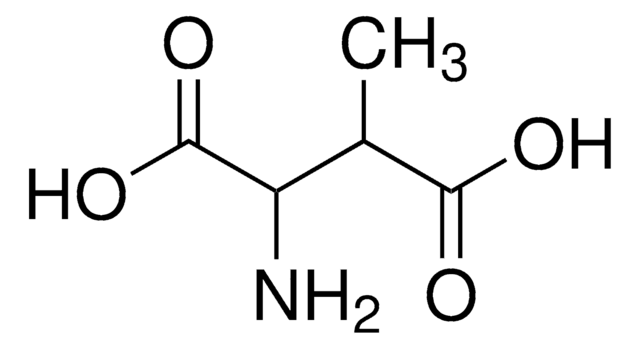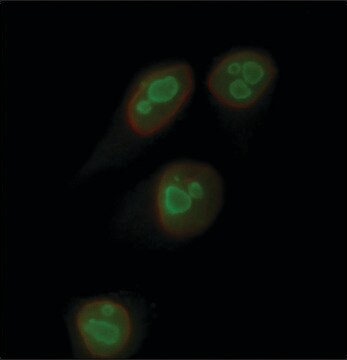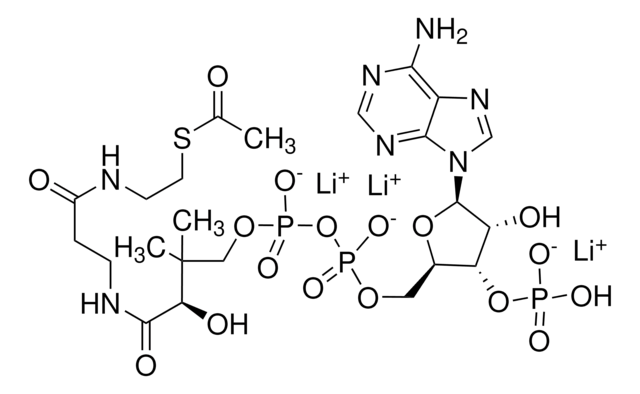N2662
Anti-Nucleolin antibody produced in rabbit
affinity isolated antibody, buffered aqueous solution
Synonym(s):
Anti-C23
Sign Into View Organizational & Contract Pricing
Select a Size
All Photos(2)
Select a Size
Change View
About This Item
Recommended Products
biological source
rabbit
Quality Level
conjugate
unconjugated
antibody form
affinity isolated antibody
antibody product type
primary antibodies
clone
polyclonal
form
buffered aqueous solution
mol wt
antigen 105 kDa
species reactivity
mouse, rat, human
packaging
antibody small pack of 25 μL
General description
Anti-Nucleolin is produced in rabbit using as immunogen a synthetic peptide of human nucleolin with C-terminal added cysteine conjugated to KLH. Nucleolin contains a specific bipartite nuclear localization signal sequence and three different structural domains. The N-terminal domain comprises of highly acidic regions separated by basic sequences and contains multiple phosphorylation sites. The central domain contains four RNA-binding domains (RBD or RRM) and the C-terminal domain (GAR or RGG) is rich in glycine, arginine, and phenylalanine residues. N and C terminal domains are involved in protein-protein interaction whereas the central domain is involved in specific interactions with nucleic acids. Nucleolin is mainly localized in the nucleus and at the cell surface of cultured tumor cells and endothelial cells of angiogenic vessels in vivo.
Nucleolin, also known as C23, is the major nucleolar protein of exponentially growing eukaryotic cells. It is a ubiquitous conserved multi-domain phosphoprotein found in all vertebrate species. Nucleolin is a multifunctional protein involved in most steps of ribosome biogenesis. It has been implicated in chromatin structure, rDNA transcription, rRNA maturation, ribosome assembly, cytokinesis, nucleogenesis, cell proliferation and growth, and nucleo-cytoplasmic transport.
Rabbit polyclonal anti-Nucleolin antibody recognizes human, mouse, and rat nucleolin. Detection of the nucleolin band by immunoblotting is specifically inhibited with the immunizing peptide.
Immunogen
synthetic peptide corresponding to amino acid residues 2-17 of human nucleolin with C-terminal added cysteine, conjugated to KLH. The corresponding sequence differs by 4 amino acids in rat and mouse nucleolin and by 1 amino acid in the rat homolog protein NRP (nucleolin related protein).
Application
Applications in which this antibody has been used successfully, and the associated peer-reviewed papers, are given below.
Western Blotting (1 paper)
Western Blotting (1 paper)
Rabbit polyclonal anti-Nucleolin antibody is used to tag nucleolin for detection and quantitation by immunocytochemical and immunohistochemical (IHC) techniques such as immunoblotting (105 kDa), immunoprecipitation, and immunofluorescence. It is used as a probe to determine the presence and roles of nucleolin in ribosome maturation, cytokinesis, nucleogenesis, cell proliferation and growth, and nucleo-cytoplasmic transport in exponentially growing eukaryotic cells.
Biochem/physiol Actions
Nucleolin also exhibits auto degradation, DNA and RNA helicase activities, and DNA-dependent ATPase activity. Nucleolin activities may be regulated by proteolysis, methylation, ADPribosylation and phosphorylation by several kinases, including casein kinase II (CK2), p34cdc2 and protein kinase C. Nucleolin might function as a cell surface receptor for lipoproteins, viruses, extracellular matrix, growth factors and other molecules. It interacts with telomerase, which is critical for the nucleolar localization of telomerase.
Physical form
Solution in 0.01 M phosphate buffered saline, pH 7.4, containing 15 mM sodium azide.
Disclaimer
Unless otherwise stated in our catalog or other company documentation accompanying the product(s), our products are intended for research use only and are not to be used for any other purpose, which includes but is not limited to, unauthorized commercial uses, in vitro diagnostic uses, ex vivo or in vivo therapeutic uses or any type of consumption or application to humans or animals.
Not finding the right product?
Try our Product Selector Tool.
recommended
Product No.
Description
Pricing
related product
Storage Class
10 - Combustible liquids
wgk_germany
WGK 1
flash_point_f
Not applicable
flash_point_c
Not applicable
Choose from one of the most recent versions:
Certificates of Analysis (COA)
Lot/Batch Number
Don't see the Right Version?
If you require a particular version, you can look up a specific certificate by the Lot or Batch number.
Already Own This Product?
Find documentation for the products that you have recently purchased in the Document Library.
Nucleolin expressed at the cell surface is a marker of endothelial cells in angiogenic blood vessels
Christian S, et al.
The Journal of Cell Biology, 163(4), 871-878 (2003)
Nucleolin: a multiFACeTed protein
Mongelard F and Bouvet P
Trends in Cell Biology, 17(2), 80-86 (2007)
Tovë M Goldson et al.
American journal of physiology. Cell physiology, 318(1), C83-C93 (2019-10-24)
Head and neck squamous cell carcinoma (HNSCC) cells bind to lymphocytes via L-selectin in a shear-dependent manner. This interaction takes place exclusively under low-shear stress conditions, such as those found within the lymph node parenchyma. This represents a novel functional
Pengfei Zhan et al.
Nature chemistry, 14(8), 958-963 (2022-06-21)
The cytoskeleton is an essential component of a cell. It controls the cell shape, establishes the internal organization, and performs vital biological functions. Building synthetic cytoskeletons that mimic key features of their natural counterparts delineates a crucial step towards synthetic
Nucleolin interacts with telomerase
Khurts S, et al.
Test, 279(49), 51508-51515 (2004)
Our team of scientists has experience in all areas of research including Life Science, Material Science, Chemical Synthesis, Chromatography, Analytical and many others.
Contact Technical Service